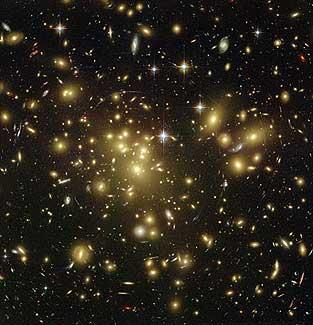The Advanced Camera for Surveys aboard NASA's Hubble Space Telescope took this photo using a 13 hour exposure time and a natural "zoom lens" in space to boost its view of the distant universe. This lens consisted of the gravity of the trillion stars of one of the most massive galaxy clusters known, called Abell 1689, which is located 2.2 billion light-years away and acts as a "gravitational lens" which bends and magnifies the light of galaxies located far behind it.
Hubble astronomers speculate that some of the faintest objects in the picture are probably over 13 billion light-years away.
The picture is an exquisite demonstration of Albert Einstein's prediction that gravity warps space and therefore distorts a beam of light, like a rippled shower curtain. Though Einstein realized this effect would happen in space, he thought it could never be observed from Earth. Though individual stars lens background light, the deflection was too small to ever be seen from Earth.
For more details check out:
article about background picture on our home web page
You can find Hubble pictures and information at:
Hubble pictures and information

More: Hubble and Keck Team Up to Find Farthest Known Galaxy in Universe
More about gravatational lenses.
The latest (January 12, 2011) about gravatational lenses. Follow the links to get the full story.
Microsoft and NASA Bring Mars Down to Earth Through the WorldWide Telescope
WorldWide Telescope (WWT) enables your computer to function as a virtual telescope, bringing together imagery from the best ground and space-based telescopes in the world. Experience narrated guided tours from astronomers and educators featuring interesting places in the sky.
A web-based version of WorldWide Telescope is also now available. This version enables seamless, guided explorations of the universe from within a web browser on PC and Intel Mac OS X by using the power of Microsoft Silverlight 3.0.
Windows® System Requirements
(For Mac OS X use the Web Client)
Mac & PC - Compare Client Versions
Astronomy Magazine
Sky and Telescope Magazine
space-astronomy magizne
The Very Long Baseline Array
Chandra X-Ray Observatory
The Chandra X-rayThe Chandra X-ray Observatory is the world's most powerful X-ray telescope. It has eight-times greater resolution and is able to detect sources more than 20-times fainter than any previous X ...
is the world's most powerful X-ray telescope. It has eight-times greater resolution and is able to detect sources more than 20-times fainter than any previous X ...
Chandra X-ray Observatory Center, Gateway to the Universe of X-ray Astronomy
Chandra X-Ray Observatory
Spitzer Infrared Space Telescope
Lowell Observatory
A 4.3-meter telescope rising seven stories above the top of a cinder cone forty miles from Flagstaff.
The website of the Palomar Observatory.
W. M. Keck Observatory
Comprised of two ten meter telescopes includes information on equipment and instruments, with images and movies, observing information, and news.
Mount Wilson Observatory
Founded in December 1904 by George Ellery Hale, Mount Wilson Observatory would quickly rise to dominate astronomy worldwide.
It was successively home to the world's two largest telescopes as well as the most powerful facilities in existence for
studying the sun. Those pioneering instruments and the brilliant scientists who used them revolutionized astronomy through
such discoveries as:
relocating the sun far from the center of the Milky Way galaxy
the existence of countless galaxies and an enormous Universe
the magnetic field of the sun and its key role in solar activity
the recession of the galaxies implying the Big Bang
populations of stars of various ages
In the twenty-first century, the Observatory hosts several of the most technologically advanced facilities in the world for
studying astronomical objects with unprecedented resolution and clarity. The 100-inch Hooker telescope remains in active
scientific service, and the solar towers are daily collecting data representing the world's longest continuous record of the sun.
Physorg - Astronomy news
Free JavaScripts provided
by The JavaScript Source

